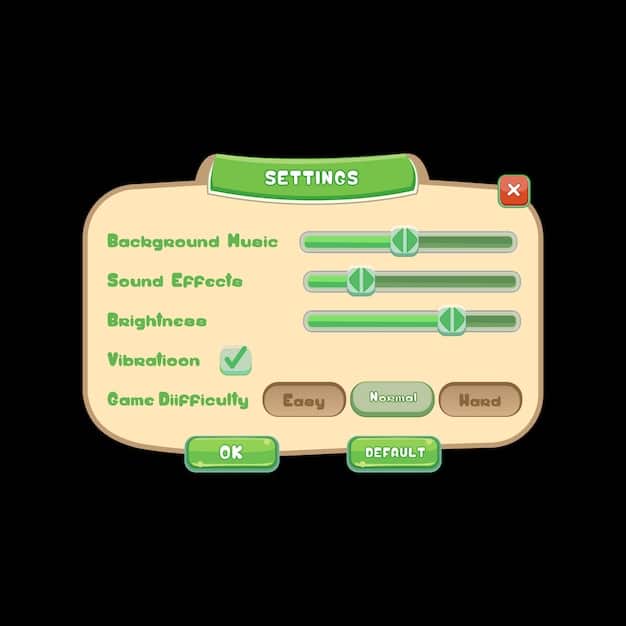Day-One Patches & PC Game Reviews: 2025 Impact Analysis

The evolving landscape of PC game development by 2025 sees day-one patches significantly influencing initial review scores, as critics increasingly factor pre-release build stability and post-launch fixes into their evaluations, shifting the perception of game readiness.
In the dynamic world of PC gaming, the launch of a new title is often met with a mix of anticipation and trepidation. A significant factor shaping early impressions and, consequently, review scores, is the presence – or absence – of day-one patches. As we look towards 2025, understanding the impact of day-one patches on PC game review scores: a 2025 perspective becomes crucial for both developers striving for critical acclaim and players seeking reliable information.
The evolving role of day-one patches in PC gaming
Day-one patches, once a relatively minor bug-fixing tool, have transformed into an almost indispensable component of modern PC game releases. In 2025, they represent more than just minor adjustments; they often carry significant weight, addressing critical bugs, performance issues, and even adding content that might not have been ready for the initial “gold” master disc.
This evolution highlights a fundamental shift in game development cycles. The pressure to meet release deadlines, coupled with the immense scale and complexity of contemporary titles, means that game development often continues right up until, and beyond, the launch day. Reviewers, inherently aware of this trend, are adapting their methodologies to account for these post-launch updates, moving beyond a “snapshot” review of the pre-patch build.
Beyond bug fixes: content and optimization
What sets 2025’s day-one patches apart is their scope. It’s no longer just about squashing a few minor bugs reported by QA. These patches frequently include:
- Performance optimizations vital for a smooth gameplay experience across varied hardware.
- Critical bug resolutions that can prevent game-breaking crashes or progression blockers.
- Additional features or content that were not complete for the initial release version.
This reality forces reviewers to consider whether their pre-launch assessment truly reflects the player experience upon release. The challenge lies in balancing the review of the “gold” version with the expectation of a significant day-one update.
The gaming community’s growing awareness of day-one patches also plays a role. Players often expect these updates and sometimes even anticipate them as a necessary evil to ensure a stable and complete experience. This collective expectation subtly influences how initial reviews are perceived, adding a layer of nuance to how scores are interpreted.
Ultimately, the role of day-one patches has expanded from a development afterthought to an integral, and often anticipated, part of the game’s lifecycle. This paradigm shift requires a re-evaluation of traditional review processes and scoring mechanisms to accurately reflect the true state of a game at launch and beyond.
Reviewer dilemma: pre-patch vs. post-patch evaluation
The core of the day-one patch conundrum for game reviewers centers on the timing of their evaluation. Traditionally, reviews are conducted on a pre-release build, often weeks before the game’s official launch. This is necessary to meet publication deadlines coinciding with embargo lifts.
However, when a large day-one patch is confirmed or even hinted at, reviewers face a significant dilemma. Do they review the game as it stands on the pre-release build, knowing it will be significantly altered on launch day? Or do they delay their review, potentially missing key embargo times, to assess the post-patch version?
Strategies for evaluating patched experiences
By 2025, a common strategy adopted by many major review outlets involves playing both versions. Reviewers might spend considerable time with the pre-patch build to form initial impressions and identify issues. Then, upon receiving the day-one patch, they allocate additional time to re-evaluate critical aspects. This includes:
- Re-testing performance metrics.
- Verifying fixes for major bugs encountered earlier.
- Assessing any new content or features introduced by the patch.
This dual-phase approach, while demanding on time and resources, aims to provide the most accurate representation of the game players will experience. It acknowledges the fluid nature of modern game development, where the “finished” product often isn’t truly complete until after launch.
Some critics also opt for a “living review” model, where an initial score and impression are published, followed by an update once the day-one patch is live. This transparency informs readers about the state of the game at different stages and allows for adjustments to the final score if significant changes occur.
The integrity of a review hinges on its relevance. If a review is based solely on a buggy pre-patch build that no one will ever play, its value diminishes. Therefore, the industry is increasingly leaning towards methods that incorporate the day-one patch’s impact, even if it introduces logistical challenges for reviewers.
The direct correlation between patch quality and score fluctuations
It’s an undeniable truth in 2025: the quality and scope of a day-one patch can directly influence a game’s review score. A poorly optimized or buggy pre-release build can be dramatically improved by a strong day-one patch, leading to a higher final score than initially anticipated. Conversely, a highly anticipated game might fall flat if its day-one patch fails to address critical issues or introduces new ones.
Reviewers are often upfront about their experience with pre-release builds, but their ultimate judgment is reserved for the version available to the public. If a game launches with significant flaws that are then fixed post-launch, the initial reviews may reflect those flaws, creating an early negative perception that can be hard to shake, even if the patch later improves the game.

Case studies and trends in 2025
We’ve observed several instances where a game’s trajectory was significantly altered by its day-one patch. Games that launched with performance woes often saw their scores jump by several points after a substantial patch. This underscores the importance of a capable technical team working right up to the wire.
Conversely, titles that released with a litany of bugs and had ineffective day-one patches suffered severe critical backlash, sometimes permanently damaging their reputation. This highlights a growing intolerance from reviewers and players alike for games that are released in a clearly unfinished state, with the expectation that a patch will “fix everything.”
The trend for 2025 indicates that reviewers are becoming less forgiving of developers who rely too heavily on day-one patches to fix fundamental problems. While minor bug fixes are understandable, major overhauls expected at launch are increasingly viewed as a symptom of rushed development, and this opinion often reflects in the final score. The onus is on developers to deliver a reasonably polished experience out of the box, even with the understanding that a day-one patch may follow.
Player perception vs. reviewer methodology: bridging the gap
One of the persistent challenges faced by game reviewers is aligning their methodology with player perception, especially concerning day-one patches. Players often base their initial purchase decisions on early reviews, which might be published hours or days before they even download the game and its day-one patch. This creates a potential disconnect, where a player’s experience on a patched version differs significantly from the experience described in an early review based on a pre-patch build.
By 2025, the savvier player base is increasingly aware of this phenomenon. Many now follow reviews closely, but also wait for a few days post-launch to see if early player reports confirm the stability and quality promised by a day-one patch. This community-driven verification can either reinforce or contradict initial review scores.
Community feedback and “review bombing”
Platforms like Steam and Metacritic allow immediate player feedback, which can have a rapid and substantial impact. If a game launches buggy, regardless of an announced day-one patch, it can be subjected to “review bombing”—a rapid influx of negative user reviews. This immediate backlash often sets the public narrative and can influence perceptions even before critics have a chance to re-evaluate the patched version.
Reviewers are adapting by:
- Emphasizing transparency: Clearly stating which version of the game was reviewed.
- Providing updates: Revisiting reviews post-patch or offering supplemental content.
- Educating readers: Explaining the realities of modern game development cycles and patches.
The goal is to bridge the potential gap between a critic’s informed, sometimes multi-stage, assessment and a player’s raw, immediate experience. The dialogue between critics and the community around day-one patches has become more sophisticated, with both sides seeking greater understanding and accuracy in evaluating game readiness.
The shift in press cycles and embargo strategies for 2025
The pervasive nature of day-one patches has forced a significant re-evaluation of traditional press cycles and embargo strategies within the game industry. In previous years, an embargo lift typically meant a flood of reviews simultaneously. By 2025, this landscape has become more nuanced, adapting to the post-launch reality of game development.
Developers and publishers are now more frequently providing review builds earlier, often alongside the day-one patch, or pushing embargoes closer to launch to allow reviewers more time with the polished version. Some even implement rolling embargos specifically for patch-related content, giving reviewers a window to update their evaluations.
Publisher responsibility and communication
Effective communication from publishers has become paramount. Clearly articulating the content and expected impact of a day-one patch is crucial for managing reviewer expectations. Providing reviewers with the patch in a timely manner—ideally pre-launch—allows them to incorporate its effects into their initial evaluation. This proactive approach helps to avoid negative initial impressions based on an outdated build.
Moreover, some development studios are now hosting pre-launch sessions for reviewers that simulate the day-one patch experience, allowing critics to see the “final” product before it ships. This transparency is key to building trust and ensuring fair review coverage.
The industry is recognizing that forcing reviews based strictly on a pre-patch build can be detrimental to a game’s reputation if the patch significantly alters the experience. Therefore, there’s a collective push towards more flexible and intelligent embargo systems that better reflect the dynamic nature of PC game releases in 2025.
This shift isn’t just about PR; it’s about ensuring that the information reaching players is as accurate and up-to-date as possible. The goal is to move from a “launch day” mentality to a “launch window” mentality, where the game evolves immediately after release, and reviews reflect this evolution responsibly.
Forecasting the future: beyond day-one patches in 2025 and beyond
As we navigate 2025, the trend of day-one patches is unlikely to disappear. If anything, they will become even more integrated into the development cycle. However, the discussion is shifting from mere existence to the *quality* and *necessity* of these patches. The consumer and the critic are increasingly demanding that a game’s initial release should be a complete and functional experience, with day-one patches serving as refinements, not foundational fixes.
The gaming industry is also exploring new avenues to address post-launch stability. Techniques such as early access, open betas, and even “soft launches” in select regions allow developers to gather real-world data and implement fixes before a widespread global release. These methods provide a more controlled environment for identifying and resolving issues that might otherwise necessitate a massive day-one patch.
The evolving metrics for review scores
Looking ahead, it’s possible that review scores themselves might evolve to reflect this dynamic. We might see:
- More emphasis on “launch state” vs. “post-patch state” in review breakdowns.
- Review scores that are explicitly conditional, pending major patches.
- Platforms integrating dynamic review scores that update as patches are released.
The ultimate goal is to provide players with the most accurate and up-to-date information possible. As game development continues to push technological boundaries, the reliance on post-launch support and patches will remain a vital component. The key will be ensuring that these patches enhance and refine, rather than fundamentally rebuild, a game’s initial offering.
In essence, the future of PC game reviews in 2025 and beyond will require a harmonious balance between the art of critical analysis and the science of game development realities. The day-one patch, once a simple fix, has become a complex indicator of a game’s readiness, and its impact on review scores will continue to shape the industry’s discourse.

| Key Aspect | Brief Description |
|---|---|
| 🧩 Patch Evolution | Day-one patches now include significant content & optimization, not just minor fixes. |
| ⚖️ Reviewer’s Challenge | Critics balance reviewing pre-release builds vs. waiting for post-patch versions. |
| 📈 Score Fluctuation | Patch quality directly impacts scores; poor patches can severely damage reputation. |
| 🔮 Future Outlook | Expect more granular reviews and dynamic scoring reflecting live game states. |
Frequently asked questions about day-one patches and game reviews
▼
A day-one patch is a software update released by game developers at or very near the official launch date of a PC game. It typically addresses bugs, improves performance, adds missing features, or optimizes the game based on feedback from pre-release testing or late-stage development. It’s designed to ensure players experience the most polished version of the game from day one.
▼
The impact varies. If a review is based on a pre-patch build, a significant day-one patch could mean the published score doesn’t reflect the final product’s quality, potentially leading to an artificially lower score. Conversely, if the patch fixes major issues, an initial review might be updated, influencing public perception and sales. Reviewers increasingly consider the patch’s existence and effectiveness.
▼
Major review outlets often try to incorporate day-one patches into their evaluation process. This might involve playing the pre-patch build and then extensively testing the post-patch version closer to launch. While some reviews might be based purely on the pre-patch version due to embargoes, many critics now strive for methods that reflect the game’s state with the day-one patch applied.
▼
Yes, significantly. A comprehensive day-one patch that resolves critical technical issues or adds substantial missing content can drastically improve a game’s stability and playability, potentially turning a negative or mediocre review into a positive one. However, the initial negative impression can be hard to overcome, especially with early user reviews or “review bombing” influencing public perception.
▼
Absolutely. As game complexity increases and development cycles become more condensed, day-one patches have become standard practice. Developers often continue to refine and optimize games up until the very last moment, pushing out these updates to ensure players get the most complete and polished experience possible upon launch.
Conclusion
The landscape of PC game reviews has been irrevocably shaped by the ubiquitous presence of day-one patches. As we reach 2025, these updates are no longer mere afterthoughts but integral components that can make or break a game’s critical reception. Reviewers are adapting, adopting more dynamic evaluation methodologies to account for post-launch refinements. For players, understanding the role of day-one patches is key to interpreting review scores and setting realistic expectations for new releases. The dialogue between developers, critics, and the gaming community will continue to evolve, striving for transparency and accuracy in an ever-changing digital frontier.





